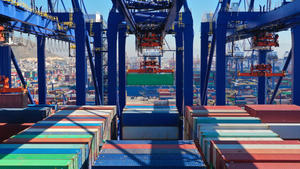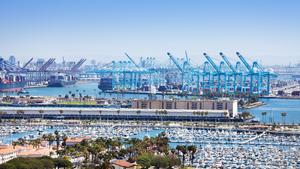The supply chain is broken, and there’s no easy fix. What’s contributing to the delays, and when will they get better? We’ve tapped furniture industry veteran and longtime editor Ray Allegrezza for a multipart series that unpacks the challenges at hand. In the fourth installment, he’s taking a closer look at the fallout from longstanding challenges in the trucking industry, from driver shortages to equipment issues.
In a perfect world, a seamless supply chain is like a perfectly choreographed baton handoff: A huge cargo ship sails into an uncongested port, crews and cranes quickly unload the containers, truck drivers receive the containers, and the containers are transported to specific destinations.
But the world is not perfect, and the supply chain is anything but seamless. Let just one of those links fumble the baton, and the race is lost.
Considering that more than 70 percent of all goods moved in the United States were transported by trucks last year, it’s easy to see the crucial role trucking plays in the supply chain. And when the trucking industry attempted to transport 10.23 billion tons of freight last year amid a host of pandemic-related speed bumps and roadblocks, it should come as no surprise that truckers found themselves pumping the brakes far more often than the accelerator.
The global supply chain was unprepared for the huge global spike in demand for goods, as well as the factory shutdowns abroad and subsequent clogged ports worldwide, all wrought by COVID. Here at home, the situation has been compounded by a shortage of truckers and truck parts and by deteriorating conditions across the transportation sector that have made it increasingly difficult for shoppers to access the things they want promptly.
Consumers today are dealing with the unpleasant trifecta of empty shelves, higher prices and longer lead times. And while it’s easy to blame the pandemic for everything that’s gone wrong, it’s also important to point out that the trucking industry had been grappling with a truckload of challenges, including a shortage of drivers, long before COVID.
In October 2021, the American Transportation Research Institute released its 17th annual report on the trucking industry’s key challenges. The results—which come from surveys of more than 2,500 industry stakeholders, including motor carriers, drivers, suppliers, driver trainers, law enforcement and more—illustrate the broad swath of challenges in the trucking sector.
For the fifth year in a row, driver shortages topped the list of industry concerns, garnering more than four times as many first-place votes as the number-two issue, driver retention. Further reflecting the workforce challenges, driver compensation was ranked third overall. This year, lawsuit-abuse reform rose three spots to number four, and the lack of available truck parking rounded out the top five. A shortage of diesel technicians made the list for the first time this year, coming in as the 10th most critical issue in the industry.
Nearly 25 percent of the survey respondents were professional truck drivers, and among driver respondents, driver compensation and truck parking tied as their number-one concerns. Detention and delay at customer facilities was ranked second by drivers.
“It is no surprise that truck-driver-related issues—notably the driver shortage and driver retention—ranked so high on the survey,” said ATRI president and COO Rebecca Brewster. “Coming out of the pandemic, with the increased demand for goods and other pressures on the supply chain, getting and keeping drivers has been a real challenge industry-wide. We also see the impacts of the current supply chain crunch in how highly issues like driver compensation, truck parking, infrastructure and driver retention ranked on the list.”
There has been a shortage of truck drivers for years, and now, a spiraling trend of drivers aging out—coupled with the exodus of those fed up with long hours, shrinking wages and increasing government regulations—is hammering an already broken supply chain.
Another study, released this past October by the American Trucking Associations, estimated the trucking industry is short by a record-breaking 80,000 drivers and warned that figure could double by 2030 as they continue to retire and leave the field.
Another major roadblock—and another that predated, but has been exacerbated by, the pandemic—is the shortage of available chassis to move the containers from still-backlogged ports.
In simple terms, a container chassis is the trailer or wheeled frame that shipping containers are placed on for ground transportation. When a terminal has a deficit of chassis, truckers are forced to wait in line until they show up, which only further impedes an already congested process. And with ongoing consumer demand, there is far more cargo than there are chassis to carry it.
Not that long ago, the shipping lines were heavily involved in owning and operating the chassis. Before the pandemic, many of these companies chose to sell this portion of their business to a handful of equipment and chassis-leasing companies, which observers say now find themselves overwhelmed by the unprecedented demand.
But this shortage, too, can be called a preexisting condition. According to industry observers, other factors playing into the problem include the trend toward larger ships, which are carrying larger numbers of containers; rising costs of chassis due to price hikes from tariffs on imported steel; a growing number of chassis in disrepair; and finally, retailers holding on to the chassis longer than normal.
The price for a new chassis can be upwards of $25,000, but the long-term losses associated with goods not getting to market seem to outweigh the cost.
So, are we just stuck in the mud with no tow truck in sight? The problems have grown so large that the White House has taken notice, recently announcing specific initiatives to address driver shortages, recruitment, pay and retention, and more.
“The pandemic exacerbated longstanding workforce challenges within the trucking trade,” the administration said in a statement in December. “Many truckers additionally bear the burden of gasoline, insurance coverage, and upkeep prices, which reduces their take-home pay, creating important challenges in recruiting and retaining drivers with the fitting credentials and expertise into at present’s trucking jobs.”
The White House plans to fast-track drivers seeking industrial licenses, boost registered apprenticeships, and concentrate on recruiting some of the 70,000 veterans who may have gained licensed trucking expertise while in the military. It is also launching the Driving Good Jobs initiative, a new partnership between the Division of Transportation and Division of Labor that will include listening sessions that engage drivers and others in the industry and identify best practices for driver retention.
As part of the initiative, the administration announced a 90-day challenge to trucking firms to develop new Registered Apprenticeship Program applications that allow apprentice truckers to get paid as they learn. The DOL additionally funded a new apprenticeship middleman associate, FASTPORT, to help trucking employers, unions, and trade associations create and implement a Registered Apprenticeship Program in as little as two days.
“The Administration is taking action, and now we are asking industry, labor and all levels of government to partner with us to address these trucking workforce challenges and begin building a next generation trucking workforce,” the White House statement said.
These are good and well-intentioned initiatives. But Rome wasn’t built in a day, and even with the Biden initiatives, truckers will still be limping down the highway in second gear. For me, a line from the Grateful Dead song “Truckin’” says it best: “What a long, strange trip it’s been.”
Homepage photo: © hit1912/Adobe Stock
____________
Ray Allegrezza is the executive director of the International Home Furnishings Representatives Association, which was founded in 1934 to focus on the needs of the industry’s sales reps. An industry veteran with more than three decades of editorial, publishing and marketing experience in the home furnishings sector, Allegrezza was the editor in chief of Furniture Today from 1995 to 2014.





























